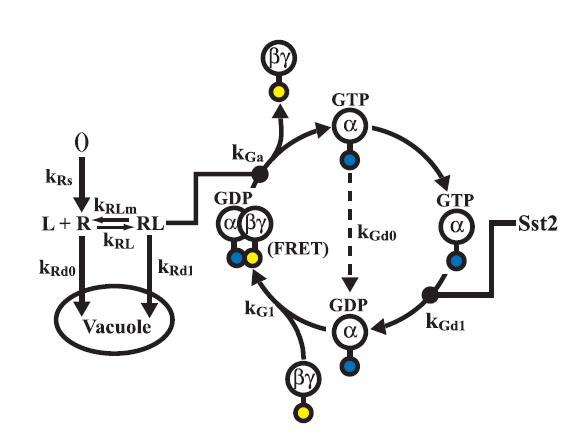Team:TU-Delft/Modeling/SingleCellModel
From 2012.igem.org
(→Model of the G - Protein cycle) |
(→Model of the G - Protein cycle) |
||
| Line 16: | Line 16: | ||
= Model of the G - Protein cycle = | = Model of the G - Protein cycle = | ||
| - | The concentration of free G-beta-gamma dimer is crucial for the activation of the MAP kinase cascade which in turn activates the[[File:ReactionDiagramYiEtal.gif|600px|middle|thumb|'''Figure 1''': Reaction diagram of heterotrimeric G protein cycle. The individual reactions comprising the key dynamics of heterotrimeric G proteins in yeast are represented along with the rate constants | + | The concentration of free G-beta-gamma dimer is crucial for the activation of the MAP kinase cascade which in turn activates the[[File:ReactionDiagramYiEtal.gif|600px|middle|thumb|'''Figure 1''': Reaction diagram of heterotrimeric G protein cycle. The individual reactions comprising the key dynamics of heterotrimeric G proteins in yeast are represented along with the rate constants]] expression of the GFP. The promoter used for the receptor and the initial concentration of the ligand were thus crucial parameters for the activation of the G-Protein Cycle. A model of the G-Protein cycle by Yi et al [[Team:TU-Delft/Modeling/SingleCellModel#Ref1|[1]]] was used to analyze the effects of the different promoter strengths of the receptor. |
| - | + | ||
It can be seen that as the concentration of G-alpha-GDP increases the concentration of free G-beta-gamma dimer reduces, which motivates the use of a promoter which is weak or medium strength compared to a strong promoter. | It can be seen that as the concentration of G-alpha-GDP increases the concentration of free G-beta-gamma dimer reduces, which motivates the use of a promoter which is weak or medium strength compared to a strong promoter. | ||
Revision as of 18:57, 20 September 2012

Contents |
Single Cell Model
The single-cell pathway model of our system is composed of 4 modules, which are responsible for routing the signal from the receptor to the GFP sythesis. The mathematical model is developed on a scheme favoring the temporal order of processes, based on the current understanding of the pheromone signalling pathway from [1][2][3] and on the feedback received from the experimentalists on the expected behaviour of the pathway, taking into consideration the aspects relevant to our project.
Model of the G - Protein cycle
The concentration of free G-beta-gamma dimer is crucial for the activation of the MAP kinase cascade which in turn activates theIt can be seen that as the concentration of G-alpha-GDP increases the concentration of free G-beta-gamma dimer reduces, which motivates the use of a promoter which is weak or medium strength compared to a strong promoter.
Model of the Yeast Pheromone Response
A model of the yeast pheromone response by Kofahl and Klipp[2] was used to test the effects of knockout on the transcription factor Ste12.
Model of the Snifformyces Pathway
The model of the G-protein cycle lacked the description of MAP kinase cascade and the gene expression module.The model of the yeast pheromone response had a detailed description of the pathway but had two drawbacks, it did not incorporate the gene expression module and more importantly was too complex in terms of the number of parameters that were present in the model. Due to the large number of parameters, fitting the limited data available from the experiments to the highly complex pathway model in [2] we felt would not have been feasible.
The above drawbacks motivated us to build a model, which would capture the crucial components of the pathway with a reduced degree of complexity i.e with lesser parameters to be identified. Combining the knowledge from [1] and [2] and also using [3], We built a new model of the pathway. The rates in this model were obtained by fitting the model to the data in [4]. It can be seen from the simulations that the model is capable of reproducing the Fus3 dynamics fairly accurately.
References
| Source | |
|---|---|
| [1] | [http://www.pnas.org/content/100/19/10764.full.pdf Tau-Mu Yi, Hiroaki Kitano, and Melvin I. Simon, A quantitative characterization of the yeast heterotrimeric G protein cycle, PNAS September 16, 2003 vol. 100 no. 19] |
| [2] | [http://onlinelibrary.wiley.com/doi/10.1002/yea.1122/pdf Kofahl B, Klipp E, Modelling the dynamics of the yeast pheromone pathway, Yeast 2004; 21: 831–850] |

 "
"

